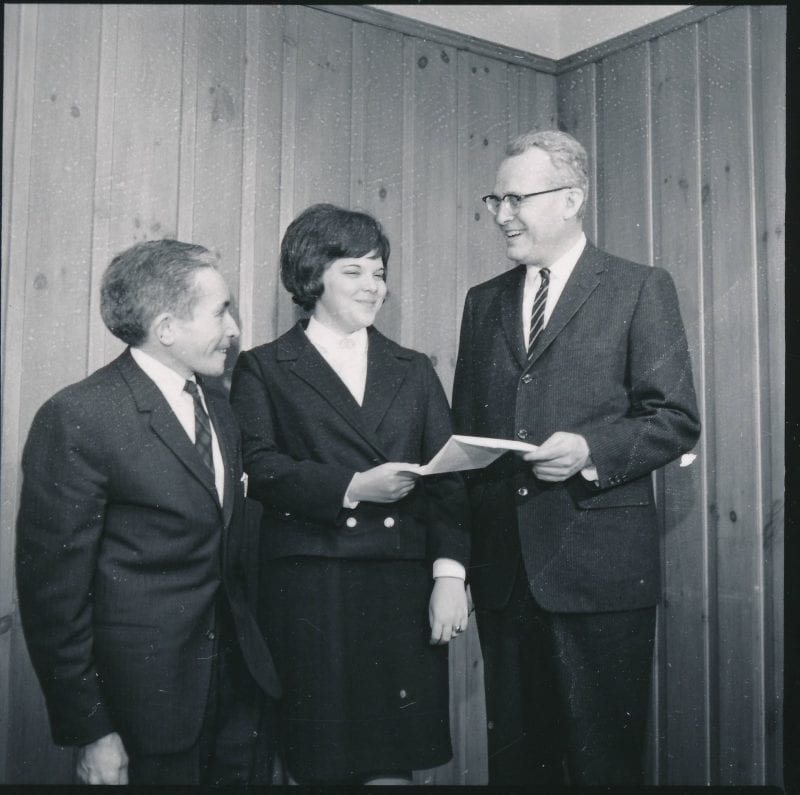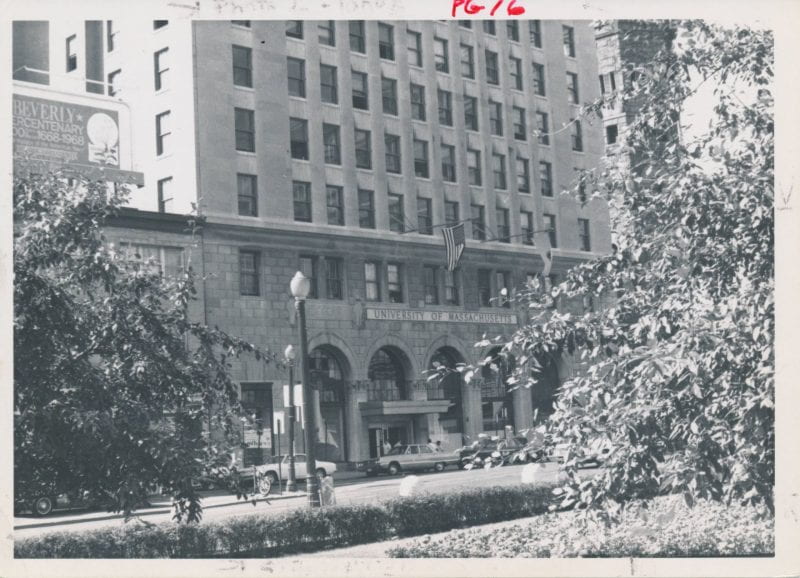Author: Kayla Allen, Archives Assistant and graduate student in the History MA Program at UMass Boston

Albert Fulchino and John W. Lederle with Audrey Taub, the first student accepted into the Boston campus of the University of Massachusetts, 1965
Until the mid-twentieth century, there was only one public university serving students in our state, the University of Massachusetts located in Amherst. In the 1960s, the Massachusetts legislature decided that we needed another: a school in the city that would serve the people of Boston and the surrounding area. The first student accepted to the Boston campus was a young woman named Audrey Taub, and the school made a big to-do of the occasion.
UMass Boston’s first campus was at Park Square, and it opened in 1965. Our collections show this community forming at a tumultuous time, a period of protest in an America ready for revolutionary change. According to David Outerbridge, class of 1970,
“Looking back through the haze of fifty years, I would like to say my four years at UMass Boston were a seamless progression of academic and personal growth. And in some measure they were, but they were also extremely difficult years when the world impinged on our lives in a way that changed the experience of college. Vietnam and the Civil Rights struggle overshadowed everything. My focus couldn’t be entirely on my studies. There were books on the war to read, teach-ins and demonstrations to go to. The pull of engagement in the world was strong.”
UMass Boston became a place where students could learn, not just academics, but about life. They were often directly participating in the struggles of their era, both on and off campus. On page seven of the September 22, 1969 edition of Mass Media, UMass Boston Afro-American Society President Alvan Johnson called for equity at UMass Boston:
“Even though advancements have been made in several areas, much more needs to be done. For instance; of a possible 275 faculty members, nine are Black; of a possible 3,500 students, six to seven percent are Black; course offerings are still very limited, and there still is no major either in African or Afro-American studies. The faculty and administration have responded to the voice of the minority in its midst.
But silence on our part now might be mistaken for contentment. I assure you, this is not the case. We have several projects to undertake, many more dragons to slay before this university is fit for people of all ‘races, creeds, and national origins.’”
We have several collections and posts to share pertaining to the Park Square campus. There are wonderful stories and photographs collected from alumni like David, faculty, and staff in the Park Square History Project on our UMass Boston Memories blog. Please browse and/or contribute!
To read more from students (like Alvan Johnson) who experienced the Park Square campus, be sure to check out our digitized run of the Mass Media.
We also have a collection of over 180 digitized photographs (and its finding aid) taken on and around the original UMass Boston campus. Many of the photographs feature the main building at 100 Arlington Street and the library in the Armory across the road. I’ve selected a few of these photographs for you to check out at the end of this post.In addition, many of the UMass Boston yearbooks have been digitized by the Internet Archive. Here you can see the 1969, 1970, and 1971 yearbooks, the three issues we have digitized that were created on the Park Square campus.
There is so much more to say about this incredible campus and the experiences of the people that learned and worked there. It feels almost impossible to conclude this post here, but I must (for now). Please keep your eyes peeled for future posts featuring the collections that tell the stories of UMass Boston.
If you’re interested in learning a bit more about 100 Arlington Street as it is now, check out this blog post written by Andrew Elder in 2014, right after the building was converted into a luxury apartment complex.

All photographs featured here are courtesy of the University Archives and Special Collections Department, Joseph P. Healey Library, University of Massachusetts Boston: University of Massachusetts Boston, historic photographs.





